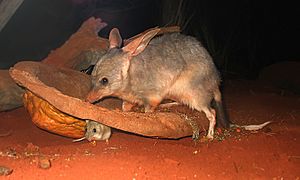Spinifex hopping mouse facts for kids
Quick facts for kids Spinifex hopping mouse |
|
|---|---|
 |
|
| Spinifex hopping mouse (small animal) and greater bilby at Sydney Wildlife World | |
| Conservation status | |
| Scientific classification | |
| Genus: |
Notomys
|
| Species: |
alexis
|
The spinifex hopping mouse (its scientific name is Notomys alexis) is a small, cute animal. It is also known as the tarkawara or tarrkawarra. You can find these mice in the dry, central, and western parts of Australia. They live in sandy areas covered with spinifex plants. They also like stable sand dunes and flat areas with mulga and melaleuca trees.
The number of spinifex hopping mice changes a lot. In normal years, there are not many of them, and they mostly stay in sandy places. But after it rains, their numbers grow very quickly! Then they spread out to live in other types of areas for a while.
These mice are mostly seen at night. They move by hopping across open ground on their big back feet. When they hop, their tails stick out, and their bodies are almost flat. They spend a lot of energy finding food and carrying it back to their homes.
What do Spinifex Hopping Mice Look Like?
The spinifex hopping mouse looks a lot like the northern hopping mouse. It is a little bigger than a common house mouse. Its head and body are about 95 to 115 millimeters (about 3.7 to 4.5 inches) long. An average mouse weighs about 35 grams (about 1.2 ounces).
Like all hopping mice, their back legs are very long. Their front legs are small. They have a very long tail, about 140 millimeters (about 5.5 inches), with a brush-like tip. Their fur is chestnut or fawn (light brown) on top and pale underneath. They have a grey color around their nose and between their eyes and ears. They also have longer, rough black hairs on their back. The tail has little fur and is pink, being darker on top than underneath.
Spinifex hopping mice live in small family groups. Up to 10 mice can live together in deep, damp burrows. Their home usually has a large nest room about one meter (about 3 feet) underground. This room is lined with small sticks and other plant bits. Several tunnels lead straight up from the nest room to the surface. You won't see piles of dirt outside the entrances to these tunnels.
Life Cycle and Reproduction
Spinifex hopping mice can have babies at any time of the year. This depends on how good the conditions are, but spring is a favorite time. Pregnancy usually lasts for 38 to 41 days. However, it can take much longer if the mother is still feeding her last group of babies.
They usually have three or four babies at a time. The most they can have is six. The young mice stay in the nest while the mother goes out to find food. If the babies wander off, both the male and female adults will bring them back to the nest. The young mice become old enough to have their own babies in about two and a half months.
The spinifex hopping mouse is found in many places. Even though their numbers change a lot, they are not considered to be in danger.
Spinifex Hopping Mice as Pets
In the past, you needed a special license to keep spinifex hopping mice as pets in Victoria and ACT (Australia). But in 2013, the rules changed. Now, you can own spinifex hopping mice as pets in Victoria without needing a license. However, people who breed them to sell still need a license. This helps make sure that mice are not taken from the wild.
If you have a spinifex hopping mouse as a pet, you should know about possible health risks. These can include tiny bugs called mites or worms. In very rare cases, they can even get a type of skin problem called melanoma.


